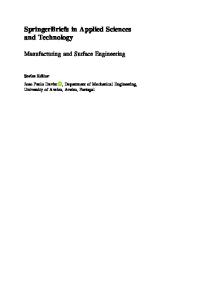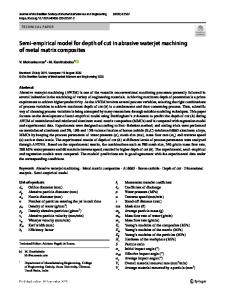Hybrid Approach for Prediction and Modelling of Abrasive Water Jet Machining Parameter on Al-NiTi Composites
In this work, pure aluminium and NiTi is used as matrix and reinforcement to fabricate a smart composite. To get an improved mechanical property, primarily the powder metallurgy process parameters are optimized, and the best processing parameters are used
- PDF / 540,943 Bytes
- 21 Pages / 439.37 x 666.142 pts Page_size
- 99 Downloads / 316 Views
Hybrid Approach for Prediction and Modelling of Abrasive Water Jet Machining Parameter on Al-NiTi Composites S. Rajesh, Anish Nair, M. Adam Khan, and N. Rajini Abstract In this work, pure aluminium and NiTi is used as matrix and reinforcement to fabricate a smart composite. To get an improved mechanical property, primarily the powder metallurgy process parameters are optimized, and the best processing parameters are used for the fabrication of composites materials and subsequently the composite is used for machining studies. Abrasive Water Jet Machining (AWJM) process is used to study the machinability characteristics of the Al- NiTi smart composites. To study the effect of AWJM parameters on Al-NiTi composites, the following control variables identified are Transverse Speed (TS), Applied Pressure (AP), Standoff Distance (SoD), % Wt. of reinforcements (wt%), Abrasive Size (AS). The output indices are Surface Roughness (Ra ) and Kerf Angle (Ka ). The experiments are designed and conducted based on the design of experiment. Further, it describes the effectiveness of the hybrid algorithm in predicting and optimizing the Abrasive Water Jet Machining (AWJM) parameters. Grey Relational Analysis (GRA) is used as a feature selection and optimizing tool. The result of feature selection by GRA– Entropy, reveals that the most influencing control variables are ranked in the order as AS, AP, TS, wt% and SoD. Modelling of AWJM process is done by Support Vector Machine algorithm (SVM), and the performance of the model is compared with SVM hybrid models. A hybrid model is developed with the concept of Differential Evolutionary algorithm (DE) and Entropy. Hybrid SVM–Entropy model displayed increased prediction performance by 37.8% compared to the SVM model. GRA– SVM–Entropy hybrid model is compared with the SVM model, it is found that the prediction performance of the GRA–SVM–Entropy hybrid model increased by S. Rajesh (B) · A. Nair · M. Adam Khan · N. Rajini Department of Mechanical Engineering, Kalasalingam University, Krishnankoil, India e-mail: [email protected] A. Nair e-mail: [email protected] M. Adam Khan e-mail: [email protected] N. Rajini e-mail: [email protected] © Springer Nature Switzerland AG 2021 S. Pathak (ed.), Intelligent Manufacturing, Materials Forming, Machining and Tribology, https://doi.org/10.1007/978-3-030-50312-3_8
173
174
S. Rajesh et al.
49.1%. It is found from the GRA–Entropy method; the optimal conditions are A2, B1, C1, D3, and E1. Keywords Al-NiTi · AWJM · GRA · Entropy · SVM · DE
8.1 Introduction The demands for the advanced materials in modern manufacturing industries (automobile, aerospace and advanced electronics and biomedical system) are in exponential form because of the competitiveness among the industries. In advance materials, the importance of metal matrix composites cannot be alleviated because of its excellent strength to stiffness ratio. Almost in all aerospace and automobile industries, major components are being replaced by metal matrix composites. The uniqueness of this materi
Data Loading...











